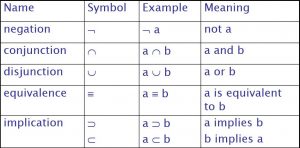January 13rd, 2018
In this last and final session of the semester, we re going to discuss about Logic Programming Languages.
so what is Logic Programming Languages.
Logic programming is a type of programming paradigm which is largely based on formal logic. Any program written in a logic programming language is a set of sentences in logical form, expressing facts and rules about some problem domain. Major logic programming language families include Prolog, Answer set programming (ASP) and Datalog.
Proposition
A logical statement that may or may not be true
–Consists of objects and relationships of objects to each other
Symbolic Logic
Logic which can be used for the basic needs of formal logic:
–Express propositions
–Express relationships between propositions
–Describe how new propositions can be inferred from other propositions
Particular form of symbolic logic used for logic programming called predicate calculus
Object Representation
- Objects in propositions are represented by simple terms: either constants or variables
- Constant: a symbol that represents an object
- Variable: a symbol that can represent different objects at different times
–Different from variables in imperative languages
Compound Terms
- Atomic propositions consist of compound terms
- Compound term: one element of a mathematical relation, written like a mathematical function
–Mathematical function is a mapping
–Can be written as a table
Parts of a Compound Term
Compound term composed of two parts
–Functor: function symbol that names the relationship
–Ordered list of parameters (tuple)
Examples:
student(jon)
like(seth, OSX)
like(nick, windows)
like(jim, linux)
Forms of a Proposition
Propositions can be stated in two forms:
–Fact: proposition is assumed to be true
–Query: truth of proposition is to be determined
Compound proposition:
–Have two or more atomic propositions
–Propositions are connected by operators
Logical Operators

Quantifiers

Overview of Logic Programming
Declarative semantics
–There is a simple way to determine the meaning of each statement
–Simpler than the semantics of imperative languages
Programming is nonprocedural
–Programs do not state now a result is to be computed, but rather the form of the result
Terms
- This book uses the Edinburgh syntax of Prolog
- Term: a constant, variable, or structure
- Constant: an atom or an integer
- Atom: symbolic value of Prolog
- Atom consists of either:
- a string of letters, digits, and underscores beginning with a lowercase letter
- a string of printable ASCII characters delimited by apostrophes
Terms: Variables and Structures
- Variable: any string of letters, digits, and underscores beginning with an uppercase letter
- Instantiation: binding of a variable to a value
- Lasts only as long as it takes to satisfy one complete goal
- Structure: represents atomic proposition
functor(parameter list)
Fact Statements
- Used for the hypotheses
- Headless Horn clauses
female(shelley).
male(bill).
father(bill, jake).
Rule Statements
- Used for the hypotheses
- Headed Horn clause
- Right side: antecedent (if part)
- May be single term or conjunction
- Left side: consequent (then part)
- Must be single term
- Conjunction: multiple terms separated by logical AND operations (implied)
Goal Statements
- For theorem proving, theorem is in form of proposition that we want system to prove or disprove – goal statement
- Same format as headless Horn
man(fred)
- Conjunctive propositions and propositions with variables also legal goals
father(X, mike)
Inferencing Process of Prolog
- Queries are called goals
- If a goal is a compound proposition, each of the facts is a subgoal
- To prove a goal is true, must find a chain of inference rules and/or facts. For goal Q:
P2 :- P1
P3 :- P2
…
Q :- Pn
- Process of proving a subgoal called matching, satisfying, or resolution
Approaches
- Matching is the process of proving a proposition
- Proving a subgoal is called satisfying the subgoal
- Bottom-up resolution, forward chaining
- Top-down resolution, backward chaining
- Prolog implementations use backward chaining
Subgoal Strategies
- When goal has more than one subgoal, can use either
- Depth-first search: find a complete proof for the first subgoal before working on others
- Breadth-first search: work on all subgoals in parallel
- Prolog uses depth-first search
- Can be done with fewer computer resources
Backtracking
- With a goal with multiple subgoals, if fail to show truth of one of subgoals, reconsider previous subgoal to find an alternative solution: backtracking
- Begin search where previous search left off
- Can take lots of time and space because may find all possible proofs to every subgoal
Simple Arithmetic
- Prolog supports integer variables and integer arithmetic
- is operator: takes an arithmetic expression as right operand and variable as left operand
A is B / 17 + C
- Not the same as an assignment statement!
- The following is illegal:
Sum is Sum + Number.
Trace
- Built-in structure that displays instantiations at each step
- Tracing model of execution – four events:
- Call (beginning of attempt to satisfy goal)
- Exit (when a goal has been satisfied)
- Redo (when backtrack occurs)
- Fail (when goal fails)
List Structures
- Other basic data structure (besides atomic propositions we have already seen): list
- List is a sequence of any number of elements
- Elements can be atoms, atomic propositions, or other terms (including other lists)
[apple, prune, grape, kumquat]
[] (empty list)
[X | Y] (head X and tail Y)
Deficiencies of Prolog
- Resolution order control
- In a pure logic programming environment, the order of attempted matches is nondeterministic and all matches would be attempted concurrently
- The closed-world assumption
- The only knowledge is what is in the database
- The negation problem
- Anything not stated in the database is assumed to be false
- Intrinsic limitations
- It is easy to state a sort process in logic, but difficult to actually do—it doesn’t know how to sort
Applications of Logic Programming
- Relational database management systems
- Expert systems
- Natural language processing
